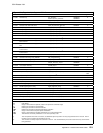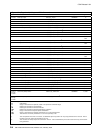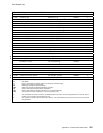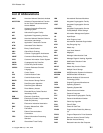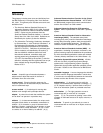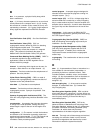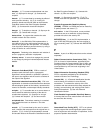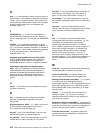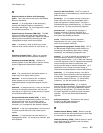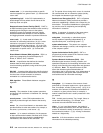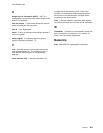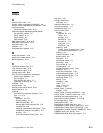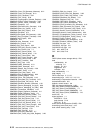CCA Release 2.54
decipher. (1) To convert enciphered data into clear
data. (2) Synonym for decrypt. (3) Contrast with
encipher.
decode. (1) To convert data by reversing the effect of
some previous encoding. (A) (I) (2) In the CCA
products, decode and encode relate to the Electronic
Code Book mode of the Data Encryption Standard
(DES). (3) Contrast with encode and decipher..
decrypt. (1) To decipher or decode. (2) Synonym for
decipher. (3) Contrast with encrypt.
device driver. A program that contains the code
needed to attach and use a device.
device ID. In the IBM 4758 CCA implementation, a
user-defined field in the configuration-data that can be
used for any purpose the user specifies. For example,
it can be used to identify a particular device, by using a
unique ID similar to a serial number.
diagnostic. Pertaining to the detection and isolation of
errors in programs, and faults in equipment.
directory server. A server that manages key records
in key storage by using an Indexed Sequential Access
Method.
E
Electronic Code Book (ECB). ECB is a mode of
operation used with block cipher cryptographic
algorithms in which plaintext or ciphertext is placed in
the input to the algorithm and the result is contained in
the output of the algorithm.
Electronics Industries Association (EIA). EIA is an
organization of electronics manufacturers that advances
the technological growth of the industry, represents the
views of its members, and develops industry standards.
encipher. (1) To scramble data or to convert data to a
secret code that masks the meaning of the data to
unauthorized recipients. (2) Synonym for encrypt.
(3) Contrast with decipher. (4) See also encode.
enciphered data. Data whose meaning is concealed
from unauthorized users or observers. See also
ciphertext.
encode. (1) To convert data by the use of a code in
such a manner that reconversion to the original form is
possible. (T) (2) In the CCA implementation, decode
and encode relate to the Electronic Code Book mode of
the Data Encryption Standard. (3) Contrast with
decode. (4) See also encipher.
encrypt. (1) Synonym for encipher. (T) (2) To
convert clear text into ciphertext. (3) Contrast with
decrypt.
Erasable Programmable Read-Only Memory
(EPROM). EPROM is a PROM that can be erased by
a special process and reused. (T)
exit routine. In the CCA products, a user-provided
routine that acts as an extension to the processing
provided with calls to the security API.
EXPORTER key. (1) In the CCA implementation, a
type of DES Key-Encrypting Key that can encipher a
key at a sending node. (2) Contrast with IMPORTER
key.
F
feature. A part of an IBM product that can be ordered
separately.
Federal Communications Commission (FCC). The
FCC is a board of commissioners, appointed by the
President under the Communications Act of 1934, and
having the power to regulate all interstate and foreign
communications by wire and radio originating in the
United States.
Federal Information Processing Standard (FIPS).
FIPS is a standard published by the US National
Institute of Science and Technology.
financial PIN. (1) A Personal Identification Number
used to identify an individual in some financial
transactions. To maintain the security of the PIN,
processes and data structures have been adopted for
creating, communicating, and verifying PINs used in
financial transactions. (2) See also Personal
Identification Number.
Flash-Erasable Programmable Read-Only Memory.
A memory that has to be erased before new data can
be saved into the memory.
G
Generalized Trace Facility (GTF). GTF is an optional
service program that records significant system events,
such as supervisor calls and start I/O operations, for the
purpose of problem determination.
Glossary X-5



